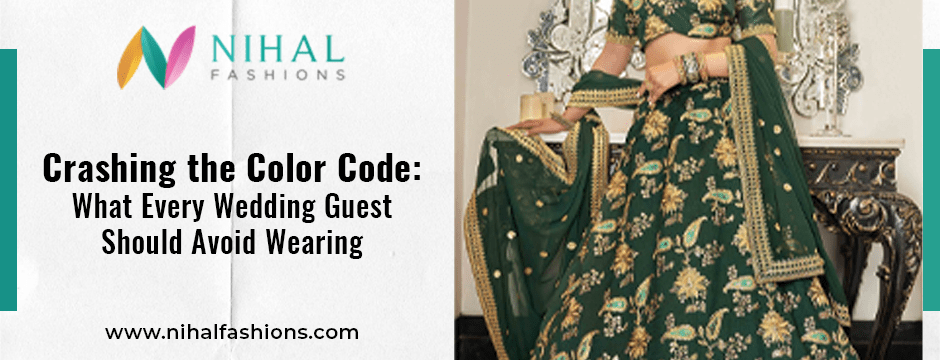Indian weddings are a vibrant explosion of color, culture and celebration. But while guests are encouraged to dress up and go all out, there is an unspoken color code that can make or break your clothing choice. And no, just because it’s pretty doesn’t mean it’s appropriate.
Knowing the Colors you should not wear at an Indian wedding. It is as important as choosing the right accessories or the perfect fit of the lehenga. Because tradition plays a huge role in every outfit seen at these events, from the bride’s bridal red to the understated elegance of the elders, your wardrobe should strike a balance between respect and style.
Let’s figure out what not to use and why, so you never end up being that Guest to the next big Indian wedding.
The Unspoken Rule Book of Indian Bridal Fashion
Before delving into specific nuances, it’s important to understand that Indian weddings are not just parties: they are sacred, spiritual, and deeply cultural. Every ritual has symbolism. Each color tells a story. So when guests unknowingly appear in shades that have negative connotations or upstage the bride, it’s not just a fashion slip — it’s a cultural faux pas.
While Indian fashion today is full of experimentation and people are more open-minded than ever, certain color traditions still remain strong. Whether you are attending a Hindu, Sikh, Jain, or even a cross-cultural Indian ceremony, a basic understanding of the do’s and don’ts will allow you to celebrate and not offend.
Why it’s best to leave white for funerals, not holidays
In most Indian cultures, white is associated with grief and loss. It is a color used at funerals and during periods of mourning, not at weddings. Therefore, showing up in a head-to-toe white suit, no matter how impressive, can send the completely wrong message.
This doesn’t mean you should avoid white completely. When used as an accent, border, or secondary color, it can look fresh and elegant. But wearing solid white, especially without any vibrant combinations, can be considered tone-deaf. Indian weddings are about life, celebration and joy, and white simply doesn’t convey that emotional energy in traditional settings.
Why black, although elegant, still seems out of place
Black is the universal color of elegance and formality. In Western environments, it is often the ideal location for exclusive events. But in Indian traditions, black still has a negative association. It is considered inauspicious, linked to bad luck and evil energies, especially during important life events such as weddings.
Although modern Indian couples are breaking fashion rules and wearing black lehengas or sherwanis, guests should err on the side of caution. Wearing a predominantly black outfit, especially at traditional ceremonies or ceremonies led by older generations, can draw sidelong glances and subtle disapproval.
If you love your black ensemble, mix it with brighter shades: think gold, fuchsia, emerald green or royal blue. That way, you respect the mood of the occasion and stay true to your fashion sense.
Let’s talk about red: Can you wear red to an Indian wedding?
Here is the million rupee question:Can you wear red to an Indian wedding?? The short answer? It depends.
Traditionally, red is he bridal color Especially in Hindu weddings, red symbolizes purity, prosperity and fertility. Brides usually wear red lehengas, sarees or dresses on their big day. This means that if you show up dressed in red from head to toe, you run the risk of looking like… the bride.
Wearing red at an Indian wedding It’s not offensive, but it can be uncomfortable. Guests may mistake you for the bride or accidentally steal the spotlight in photos and videos. Nobody wants to be that person.
So if you’re asking, Can I wear red to an Indian wedding?—Sure, but with limits. Opt for darker shades like maroon, wine or crimson instead of bridal red. Or mix red with other shades so that it doesn’t dominate the entire outfit. The key is to celebrate with the bride, not compete with her.
Wearing red at an Indian wedding: an elegant and sensible way
If red is your power color and you’re determined to use it, here’s how to do it without altering traditional feathers.
Choose styles where red appears on the embroidery, dupatta or borders instead of the main fabric. For example, a beige outfit with red floral embroidery is festive and respectful. Or wear a red blouse paired with a contrasting skirt or saree to tone down the tone.
This is a well thought out style. When you use red as a highlight instead of a headline, you maintain the visual harmony of the wedding and avoid unintentionally upsetting the bride.
This tip applies to both men and women: Grooms traditionally also wear red or maroon, so male guests should also avoid wearing all red.
Neon, fluorescents and the blinding brigade
We get it: bold is beautiful. But wearing colors that scream louder than the dhol can be seriously distracting. Neon pinks, greens, yellows and highlighter oranges may be trendy, but they rarely pair well with the elegance of Indian wedding aesthetics.
Indian weddings are all about grace and grandeur. Using neon or fluorescent tones can seem like an excessive effort or even disrespectful, especially in religious ceremonies such as pheras or sangeet.
If you want to look bright, opt for classic Indian shades like royal blue, mustard, emerald or rani pink. They’re festive, flattering, and traditional enough to blend in perfectly, without glowing in the dark.
Don’t overshadow the couple: sparkles, gold and excess clothing
Another big style mistake? Wear something so ornate that it competes with the couple’s outfits. Indian weddings are elaborate, yes, but remember, it’s not your fashion show. It’s theirs.
Head-to-toe sequins, ultra-heavy zardozi, or gold gowns that look like bridal couture can give the wrong impression. Even if you’re a close cousin or best friend, keep the couple’s timing in mind.
Dress beautifully, of course, but don’t try to look like a bride or groom.
Understanding the ceremony is important
Not all Indian wedding events carry the same formality or energy. A mehendi or haldi ceremony allows for lighter, more fun colors. But the main wedding ceremony or reception calls for a more elegant and respectful fashion.
Before choosing your outfit, ask what type of function you will be attending. Is it a religious ritual? A family-only event? A late night sangeet? Context matters more than you think. A mustard kurta that is perfect for haldi might look strange at a gala reception.
So when choosing colors that you won’t wear at Indian weddings, keep in mind which part of the wedding you are attending.
Indian tradition meets modern elegance
Today’s weddings combine old school rituals with a new age style. While the bride may wear pastel colors and the groom may ditch the sherwani for a tailored suit, respect for color symbolism still endures. That’s why it’s essential to understand the nuances behind each shade, even in modern settings.
Red at an Indian wedding It still carries enormous cultural weight, even if the bride wears white. Wearing red to an Indian wedding, while not disrespectful, should be done with care. The goal is to complement the wedding atmosphere, not disrupt it.
The same goes for wearing white or black. Even if your style is minimalist or monochrome, Indian weddings are the place to be colorful, or at least warm and festive.
Final Thoughts: When in Doubt, Go Traditional
If you’re ever not sure what to wear, traditional Indian clothing in jewel tones is always a safe and stunning bet. Rich tones like bottle Green, navy, mustard or eggplant never go out of style and hit all the right cultural notes.
And of course, when you’re looking for modern, elegant, culturally-friendly wedding attire that still lets your personal style shine…Nihal Fashions has your back. Their collection of Indian men’s and women’s wear combines tradition with trend and offers styles that work perfectly for every wedding occasion.
Celebrate, respect and dress accordingly, because when you honor the vibe of an Indian wedding, your style shines even brighter.



